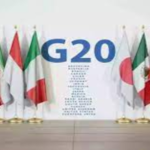India better placed than most emerging economies vs stronger Dollar

Like every other major currency in the world except the Brazilian real and the Mexican peso, the Indian rupee has also been in a free fall against the US dollar during the last few months. While the dollar, sometimes described as the “the least-ugly mug in a beauty contest”, seem to be gaining strength with every passing day, the British pound, the Japanese yen and the euro have taken most of battering, having lost 22 per cent, 20 per cent and 15 per cent of their values respectively against the dollar on a year-to-date basis. Even the Chinese renminbi has lost 11 per cent of its value.
Compared to these, the Rupee’s fall at 10 per cent from Rs 74 to Rs 82 a dollar between October 2021 and October 2022 has been rather modest. The dollar’s strength is judged by indexing it against a basket of currencies of the USA’s major trading partners like Japan and the Eurozone countries. By that measure, the trade weighted dollar index has strengthened by almost 20 per cent during the last 12 months and is now at a 20-year high – a highest appreciation for an index that typically moves by tiny fractions from day to day.
To prop up the rupee, the RBI has already spent $110 billion of its forex reserves which now stand at $532 billion, equivalent to less than nine months of imports. Even after it announced a fourth consecutive interest rate hike, a widening trade deficit driven by rising oil prices and a slowdown in exports have dragged the rupee down, steamrolled by the US Federal Reserve’s aggressive
rate-hiking campaign which is drawing global capital into the US, pushing up the dollar. Experts expect the Rupee to be trading at 82-84 against the dollar by the year end.
When global energy prices rise, energy importers like Europe suffer while exporters like the US, Brazil or Russia benefit. The Ukraine war is a major cause of the current mayhem, but even otherwise also, the dollar – the most important international currency – is considered a safe haven in troubled times. With Europe being close to a recession, and repeated lockdowns slowing export growth in China whose contagion effects are spreading to all major Asian economies, it seems the dollar’s heyday will continue for some more time.
All over the world, central banks are raising interest rates to tame inflation, but the US Federal Reserve is hiking the rates much more aggressively than most, with the result that US interest rates are now higher than in many developed economies. Naturally, this is luring the investors since even relatively conservative and safer investments like the US Treasury bonds are now offering attractive interest rates. As money pours into the US economy, the dollar is appreciating against most other currencies by more than what was witnessed during the taper tantrum of 2013. As always, emerging markets are suffering the most from this. For six straight months till August, foreign investors had pulled their funds out of emerging markets in the longest streak of withdrawals on record, and their crucial investment capital had been flying away to the relative safety of the dollar. This is, however, nothing new; earlier also, rapid rate increases by the Fed in the past had thrown the emerging economies into turmoil, like in Latin America with the “Lost Decade” in the 1980s, and the “Tequila” crisis in Mexico in the 1990s which eventually engulfed Russia and East Asia in a severe financial crisis.
Indeed, a strong dollar is posing serious economic consequences for the entire world as it is squeezing global credit because most countries borrow largely in dollars and as the dollar strengthens, dollar-denominated debts become costlier to repay out of domestic-currency revenues. The rising costs of debt servicing often outweighs the gains from exports in a devalued currency.
While a stronger dollar is expected to ease inflation in the US by making its imports
cheaper, there are other factors which are working against it, like the already elevated price levels and the relatively low unemployment rate in the USA pushing higher wage inflation. If the inflation in the US remains stubborn and forces the Fed to raise the interest rates further, the dollar’s rise will continue unabated into the next year. The impact of a strong dollar can be especially brutal for emerging economies like India, as foreign capital – especially invested in the financial markets like the FPIs – tend to flow out of their countries. Only those with higher reserves, like China, India or Brazil, can absorb the shock. As the former Treasury secretary John Connally famously told his counterparts, “The dollar is our currency, but it’s your problem.”
But even for the US economy, the impact of a strong dollar may not be all that positive. The US manufacturer and exporters will suffer as their products will face lower demands in other countries due to high prices adding to the already high US trade deficits. As the US economist William Reinsch has pointed out, historically, there have been political backlashes after the dollar has remained strong for an extended period of time which might eventually build up pressure on the Fed to reverse its interest rate hikes to make US goods competitive in the world markets. Profits of US companies like Microsoft and Nike have already nosedived. Apple generates more than 60 per cent of its sales outside the USA like the other tech giants which together dominate many stock indices. All these companies will suffer from the dollar’s increased strength. Rise of the dollar is estimated to shave five per cent off the earnings growth of the S&P 500 companies this year, amounting to more than $100 billion.
International institutions and communities must do more to?speed up debt restructuring to put countries back on a more sustainable fiscal path. For the dollar to weaken, global growth must pick up, because otherwise a downturn would only spark a continued flight of scarce capital to the perceived safety of the dollar, the world’s most important reserve currency, leading to its further appreciation. Dollar’s rise could reverse only if the
The US economy goes into a recession to make the Fed reduce the interest rates, or if a rapid reduction in price and wage pressures in the USA allows the Fed to apply a monetary break. But the dollar is unlikely to weaken unless global energy prices soften, which is again unlikely without the Russia-Ukraine war finally coming to an end.
All these possibilities now seem to be rather dim and distant, which is why it is ever more important for the world to force Russia and Ukraine to come to a negotiated understanding. The more desperate Mr Putin becomes, the more important it is for the world to force him to see reason and stop the mindless brutality.
The article is by an eminent author, Govind Bhattacharjee who is a former Director General at the Office of the Comptroller & Auditor General of India, and is a Professor at the Arun Jaitley National Institute of Financial Management and republished here for a better and clear understanding of the economic issues








